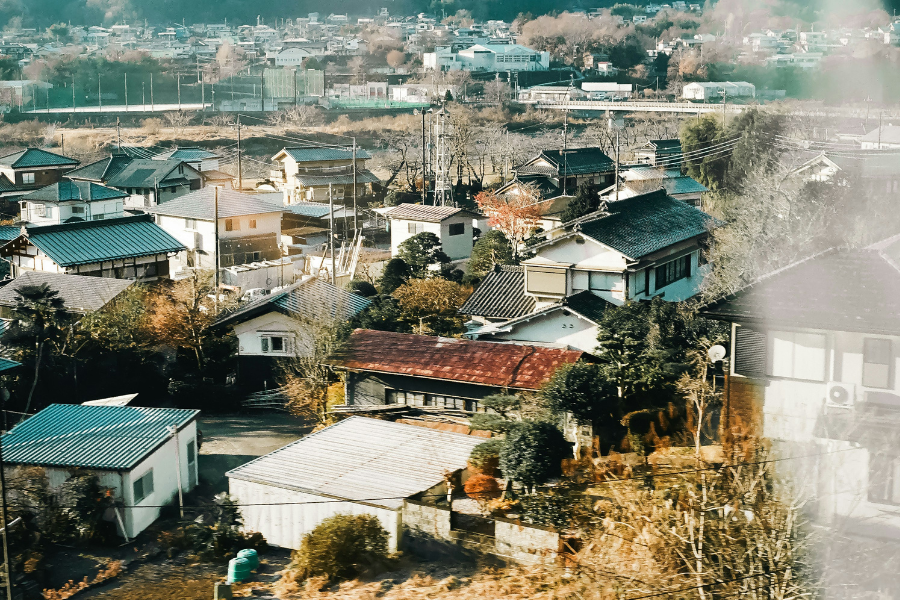Over the past 20 years, Japan has witnessed a silent crisis—millions of homes standing empty, crumbling in quiet rural towns and even urban suburbs. Known as akiya (空き家), these vacant houses have become a national symbol of population decline, economic stagnation, and social transition.
As of 2023, Japan had over 9 million abandoned homes, which is more than 13% of the country’s housing stock. By 2038, that number is expected to rise to 23 million (GoConnect.jp, 2025). This trend has deep roots in demographic shifts, outdated inheritance laws, and regional economic disparities.

What is an Akiya?
The term akiya refers to a house that is unoccupied or abandoned. While some may be structurally intact, many suffer from years of neglect. These homes are often inherited by children who have moved to cities or are left behind after elderly owners pass away. Unlike kominka, which are traditional wooden homes preserved for their cultural value, akiya may range from 30-year-old suburban homesto 100-year-old farmhouses.
Why Are There So Many?
Japan’s aging society and low birthrate have driven urban migration for decades. Rural towns are particularly vulnerable, with shrinking populations unable to sustain services or maintain infrastructure. At the same time, complex legal frameworks and reluctance to pay inheritance taxes often lead families to leave properties unclaimed (Hospitality Insights, 2025).
Adding to this, renovation costs are high, and older homes do not always meet modern building standards. Without a profitable resale value, akiya are left to decay.
Economic and Social Consequences
Municipalities shoulder the burden of monitoring and, in some cases, demolishing these structures. Akiya can become safety hazards, attract vermin, and lower surrounding property values. In many communities, these empty houses visually and psychologically reinforce the narrative of decline (Old Houses Japan, 2025).
There’s also cultural loss at stake. When historic buildings are left to collapse, Japan loses tangible connections to its rural past.
Government and Market Responses
In response, the Japanese government introduced several measures. The 2015 Vacant House Law empowered municipalities to intervene in neglected property cases. Amendments in 2023 further incentivized registration and penalized long-term neglect.
One of the most successful tools has been the development of akiya banks, online platforms where local governments list vacant properties at extremely low prices, sometimes even free (MailMate.jp, 2025). Additionally, some towns like Higashikawa in Hokkaido and Yusuhara in Kochi offer subsidies, renovation grants, and even relocation support to attract new residents (Old Houses Japan, 2025).
Akiya as Opportunity
While many see akiya as a liability, others view them as an opportunity. Foreign investors and Japanese entrepreneurs are increasingly converting abandoned homes into guesthouses, cafés, coworking spaces, and cultural hubs. This shift has been especially visible in tourism-focused regions where traditional architecture adds value (Mori, 2025).
Moreover, some towns are embracing immigration as a revitalization strategy offering foreign buyers easier visa processes if they commit to restoring and living in these homes.

Looking Forward
Japan’s akiya crisis is complex but not irreversible. The next two decades will be critical in determining whether these homes remain symbols of rural decay, or become foundations for rural renewal. Solutions will require continued legal reform, creative entrepreneurship, and inclusive community engagement.
As Japan navigates a future shaped by demographic transformation, the fate of its abandoned homes may reveal not just the cost of decline, but the possibility of reinvention.
References
- GoConnect.jp. (2025, July 1). Akiya investment in Japan: A pioneer’s guide to rural property. https://goconnect.jp/2025/07/01/invest-in-akiya/
- Hospitality Insights (EHL). (2025, June 26). How Japan’s vacant akiya houses are becoming hospitality businesses. https://hospitalityinsights.ehl.edu/japans-akiya-houses
- MailMate.jp. (2025, May 11). Top 6 akiya banks for foreigners to use in 2025. https://mailmate.jp/blog/akiya-banks-for-foreigners
- Mori, M. (2025, July 7). How Japan’s vacant akiya houses are becoming hospitality businesses. Hospitality Net. https://www.hospitalitynet.org/opinion/4128037.html
- Old Houses Japan. (2025, July 27). Rural Japanese towns with government incentives for renovation. https://www.oldhousesjapan.com/blog/rural-japanese-towns-with-government-incentives-for-renovation